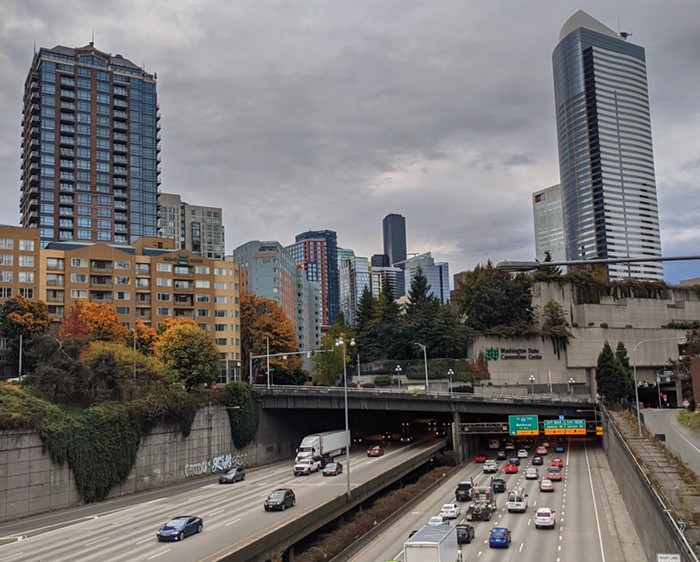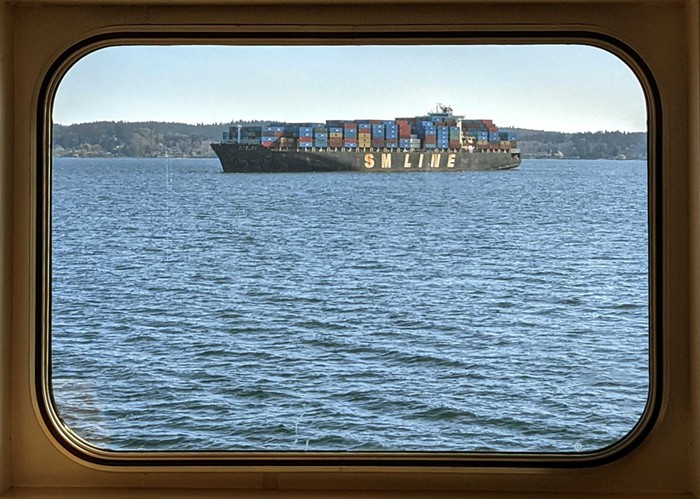
I have decided that 2021 is to be The Year of Good News, and today’s Good News is that your commute is about to get a little bit cuter.
Sharp-eyed train weirdos will have noticed that the new Sound Transit trains, recently put into service, have what appear to be futuristic lights around the door: Cool glowing strips of blue around the windows that look like the inside of a gamer’s PC. Like the self-satisfied doors on the Heart of Gold, the lights change color to indicate what the door is thinking about; and apparently this little light show has been such a hit that Sound Transit will be retrofitting the old trains to give them the same capability.
This is just one of several projects by Sound Transit’s engineers, who are also installing various smart-sensors throughout the system: In the coming years, prepare for smart sensors in the escalators, smart cameras on top of trains, and even smarter air.
These innovations are coming to you thanks to ST’s innovation program — well, really, thanks to you, since you voted for it. The Innovation and Technology Fund was approved by voters back in 2016 as part of the Sound Transit 3 ballot measure, and it’s pouring $75 million into modernizing our trains before they become a technological laughingstock. (San Francisco’s train system was running on OS/2 until 2011. Ask your compsci friends to explain why that’s so funny.)
So what’s in store? Well, there’s the blinkenlight project, installing lovely colorful lights all around the doors — green when opening, red when closing, blue when it’s holding position. This is already in place on the new Siemens-built vehicles, and they’re about to get to work on adding lights to the older Kinkyshario models. (No timeline yet for when that’ll take place.)
Elsewhere, Sound Transit will be installing cameras on top of trains — not to watch passengers, but to watch the electrical wires. Currently, if they want to inspect any of the overhead wires, they have to wait until the trains are out of service; the cameras will allow inspections while the trains are running.

Elevators and escalators will hopefully run a little more smoothly soon as well, with the installation of sensors to detect unexpected wobbles. A “Smart Step” sensor in escalators will detect when the steps are shifting out of position before the whole apparatus grinds to a halt; and a new, more verbose reporting feature in the elevators will send alerts to engineers the moment they go down, rather than waiting for an elaborate game of telephone to play out.
Also in the works is a new air filtration system for buses, not a moment too soon. (And frankly, about a year too late.)
All of these projects elicit a firm “yes, very salutary,” though it’s the lights that delight me the most. Transportation engineering is so often about the bare minimum of functionality, serviceable nuts-and-bolts, grimly constrained by brutalist logic. The lights serve a practical purpose, sure — they communicate the door’s intentions — and most light rail vehicles have some sort of light-up.
But these are so pretty. They glow like the lines on a TRON vehicle, sleek and seamless and a bit magical. And yes, in the long run, the wire inspections and the escalator sensors will probably serve a more immediate structural purpose. Still, making riders feel like they’re doing something luxury by riding public transit is important too.



















